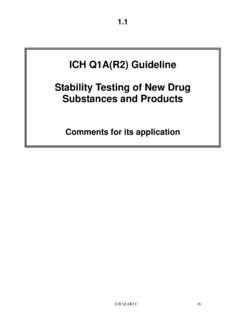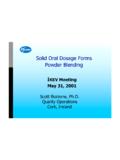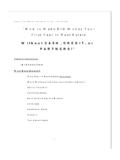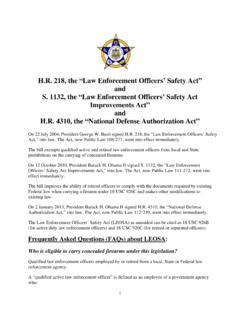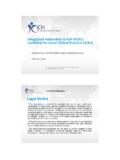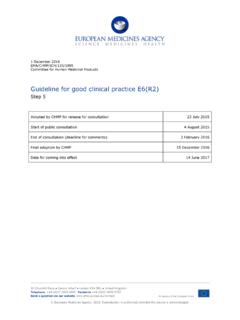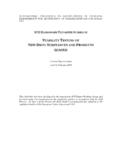Transcription of ICH Q3AR Guideline Impurity Testing Guideline Impurities ...
1 ICH q3ar Guideline Impurity Testing Guideline Impurities in New Drug Substances ICH Step 5. Comments for its application ICH Q3A(R) C 77. Impurities in New Drug Substances ICH q3ar . 1. Preamble The Guideline provides guidance for registration application on the content and qualification of Impurities in new drug substances produced by chemical synthesis. Does not apply for new drug substances used during the clinical research. Impurities are addressed from two perspectives: Chemical Aspects classification identification report generation setting specification analytical procedures Safety Aspects Guidance for qualifying Impurities - which were not present - were present at substantially lower levels in batches of a new drug substance used in safety and clinical studies 2.
2 Classification of Impurities Classification Organic Impurities (process- and drug -related). Inorganic Impurities Residual solvents Organic Impurities may arise during the manufacturing process and/or storage of the new drug substance. They may be identified or unidentified, volatile or non-volatile and include: Starting materials By-products Intermediates Degradations products ICH Q3A(R) C 78. Reagents, ligands, catalysts Inorganic Impurities are normally known and identified. Excluded Excluded are extraneous contaminants which should not occur and are generally addressed as GMP issues: polymorphic form, a solid state property, enantiomeric Impurities . 3. Rationale for Reporting and Control Impurities .
3 0rganic Impurities Summary of actual and potential Impurities most likely to arise during synthesis, purification, storage. The summary should be based on scientific appraisal of chemical reactions involved in synthesis, Impurities associated with raw materials and possible degradation products. Included only those that may reasonably expected. Summary of laboratory studies conducted to detect Impurities in new drug substance Summary should include test results of batches: manufactured in development process from proposed commercial process. of stress Testing used to identify potential Impurities arising during storage comparison Impurity profile development and commercial process 3. Rationale for Reporting and Control Impurities Studies conducted to characterise structure of actual Impurities present at level ICH Q3A(R) C 79.
4 ( > ) than identification threshold, response factor of drug substance, described. Any Impurity ( > ) than identification threshold in any batch manufactured by proposed commercial process should be identified. Degradation products ( > ) than identification threshold observed at recom- mended storage conditions should be identified. If identification not feasible, summary of laboratory studies of unsuccessful effort should be included in application. Identification of ( ) identification threshold generally not necessary 3. Rationale for Reporting and Control of Impurities Inorganic Impurities Detected and quantitated using pharmacopoeial or other appropriate procedures. Inclusion or exclusion of inorganic Impurities should be discussed.
5 Solvents According pharmacopoeial procedure. 4. Analytical Procedures Requirements for analytical procedures Documented evidence that the analytical procedures are validated and suitable for detection and quantitation of Impurities . Differences in analytical procedures used during development and proposed for commercial product should be discussed. Quantitation limit for analytical procedure not more than ( ) reporting threshold Organic Impurity levels can be measured by: comparison of analytical response for an Impurity to that - of an appropriate reference standard - of the new drug substance itself. Reference standards used should be evaluated and characterised according to intended use. ICH Q3A(R) C 80.
6 It is considered acceptable to use drug substance to estimate levels of Impurities . Are response factors not close, applicable provided a correction factor is applied or Impurities are overestimated. Acceptance criteria and analytical procedures used to estimate identified or unidentified Impurities are often based on analytical assumptions, they should be discussed. 5. Reporting Impurity Content of Batches Analytical results of all batches used for clinical safety stability Testing representative of proposed commercial process. Presentation of quantitative results Any Impurity > reporting threshold and total Impurities reported with analytical procedures Below two decimal places ( ) above one decimal place ( ).
7 Rounding using conventional rules Impurities should be designated by code number or an appropriate descriptor retention time. All Impurities (>) reporting threshold should be summed and reported as total Impurities ICH Q3A(R) C 81. 5. Reporting Impurities Content of Batches If analytical procedures change during development, reported results should be linked with the procedure used with appropriated validation information. Representative chromatograms should be provided. Representative Impurity profiles ( spiked samples) should be available if requested For each batch, the report should include: Batch identity and size Date of manufacture Site of manufacture Manufacturing process Impurity content, individual and total Use of batches Reference to analytical procedure used.
8 6. Listing of Impurities in Specifications Specifications Specifications should include a list of Impurities . Prediction of those likely to occur in commercial product - Stability studies - Chemical development studies - Routine batch analyses Those with specific acceptance criteria are referred to as specified Impurities . Specified Impurities can be identified or unidentified and should be individually listed in the specifications. A rationale for the inclusion or exclusion in the specification should be presented. Discussion of the Impurity profiles observed in the safety and chemical development batches together with a consideration of the Impurity profile of material manufactured by proposed commercial process.
9 ICH Q3A(R) C 82. 6. Listing of Impurities in Specifications Specified identified Impurities should be included along with specified unidentified Impurities estimated to be to be present ( > ) identification threshold For unidentified Impurities the procedure used and assumptions made in establishing the level of the Impurity should be clearly stated. Unidentified Impurities should be referred unidentified A. General acceptance criteria of ( ) identification threshold for any unspecified Impurity Acceptance criterion for total Impurities Limits not higher than level justified by safety data, no lower than achievable by the manufacturing process and analytical capability. Impurity specifications should be based on data of actual batches allowing sufficient latitude to deal with manufacturing and analytical variation and stability characteristics.
10 6. Listing if Impurities in Specifications Specification should include: Organic Impurities - each specified identified Impurity - each specified unidentified Impurity - any unspecified Impurity , with an acceptance criterion of ( ). identification threshold - total Impurities Residual Solvents: Inorganic Impurities Mass balance as far as possible. ICH Q3A(R) C 83. 7. Qualification of Impurities Qualification Establishing the biological safety of an individual Impurity or a given Impurity profile at levels specified. Any Impurity tested in safety or clinical studies considered qualified. Impurities which are metabolites present in animal or human studies are qualified. Thresholds Maximum Reporting Identification Qualification Daily Dose Threshold threshold threshold 2g/day or mg /day or mg /day intake (whichever is intake (whichever is lower) lower).
